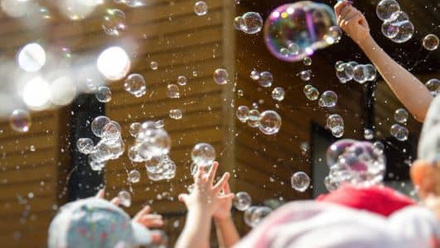4 ways to use bubbles through your playful provocations
Who doesn’t love bubbles? They’re magical concepts to young minds and can be enjoyed by anyone of any age, in a variety of different circumstances. Whether it’s to create a mindful sensory space for calming time or to use during the creation of a colourful piece of art, the use of bubbles can add so much fun to your practice.
Important: Choose a soap or foam mixture that is suitable for young, sensitive skin. Ensure that any necessary procedures for children with skin irritations or conditions, are followed. Ensure close adult supervision whilst children use bubble mixtures.
Sensory play: foamy bubbles
Bath times are best when there is an abundance of bubbly fun to be had! Recreate this sense of adventure in the playroom, by providing children with the sensory experience of diving into thick foamy bubbles, in a shallow water tray to explore with their friends. Use a whisk or high-powered tap to create thick bubbles with minimal effort. Add a drop of food colouring or essential oil to bring a multi-sensory dimension to the experience too.
Active play: chase and pop!
Nothing is more satisfying than popping bubbles! The irresistible urge to chase them down can be harnessed in this high-energy activity that encourages physical movement for all ages, whilst also supporting the development of hand-eye coordination and visual tracking.
Blowing bubbles all around, provides the opportunity for a fun and energetic game as children chase after bubbles high and low. Whether it’s reaching high or stooping to get to a bubble nearing the floor, this kind of game promotes physical activity and encourages children to move their body in different ways.
Expressive play: blowing bubbles to the music
In a more mindful state, bubbles provide a relaxing sensory and sensual experience for their audience, as they watch them drift off through the air. Give each child a bubble wand to create their own bubbles, whilst music is being played. Encourage the children to listen and tune into the music to establish a rhythm and pace for them to respond to. Fast puffs for those rapid sounds and soft gentle blows to create lots of small bubbles, when the music gets quieter. Developing a sense of musicality and learning to respond to stimuli we can hear, is a great way to think about the multi-sensory experience and get children active in the production of the bubbles too.
Infographic

Conclusion
There are so many valuable learning opportunities across your entire curriculum to be had with this cheap and accessible resource! We’ve only mentioned a few... why not add your other ideas to the forum’s ‘early learning’ discussion?






